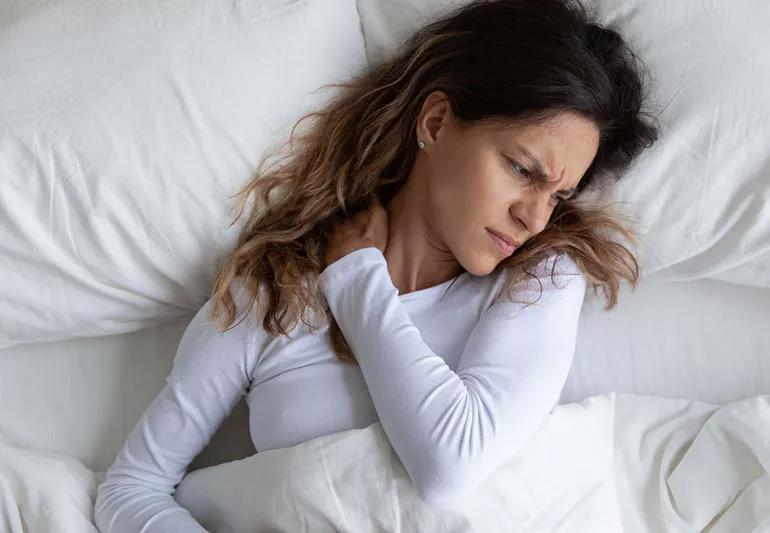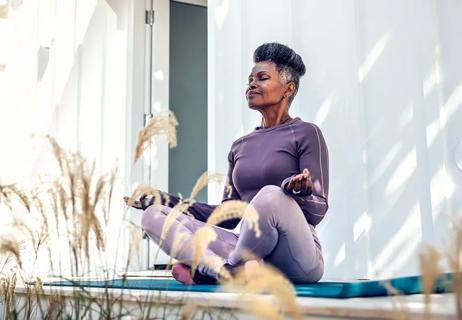Finding a neutral position can ease stress on your back, neck and shoulders

Does your lower back ache when you get out of bed in the morning? Or maybe your neck or a shoulder starts the day creaky? If so, this might be why: You’re overworking muscles when they should be off the clock.
Advertisement
Cleveland Clinic is a non-profit academic medical center. Advertising on our site helps support our mission. We do not endorse non-Cleveland Clinic products or services. Policy
Awkward sleeping positions can put stress and strain on your body as you’re catching ZZZs, leading to pain when you should be rising and shining. But you can rest easier with a few modifications.
Chiropractor Andrew Bang, DC, has some advice to put you in the best position for sleep.
Your body takes a beating during the day. “As you move around, you put a lot of stress on your ligaments, muscles, tissue and joints,” says Dr. Bang. “Sleeping provides the opportunity for everything to recover and reset.”
But that recovery doesn’t take place as it could and should if you lie down in a position that puts tension on your body while you slumber. The result? Hello, aches and pains in the a.m.!
“Your goal should be to find a neutral posture when you sleep so those ligaments that stretched out during the day can shrink and creep back to their normal position,” states Dr. Bang. “Let your body truly rest and recover.”
Here’s how to find the restful position you need if you’re dealing with certain pain points:
Good posture isn’t just important when you’re standing or sitting, notes Dr. Bang. It’s also key when you’re lying down.
Aligning your head, shoulders and hips puts your body in a neutral posture that eases stress. Your goal should be to find a position that maintains and supports the natural curves in your back and neck.
Advertisement
Let’s look at the three ways people sleep and what those positions do to your back and neck. (Spoiler alert: One is NOT ideal.)
The side (or lateral) sleeping position is the most popular — and it’s loaded with opportunities to get your body out of line. Dr. Bang offers these tips to get it right:
Want to put the least amount of pressure on your spine? Sleeping on your back is the way to go, says Dr. Bang.
But if you do sleep in this position, consider slipping a small pillow under your knees. This little lift works well with your spine’s natural curve and helps take a bit of pressure off your lower back.
“If your legs are flat, it can cause your lower back to arch too much,” he adds. “That’s especially true if you have tight hamstrings (the muscles at the back of your thigh), which is pretty common given how many hours a day most of us spend sitting.”
For your pillow, look for a height that keeps your head in a neutral position to reduce strain on your neck. A pillow that’s too low will send your jaw pointing toward the ceiling; too high, and your jaw aims toward your chest.
Snoozing on your stomach doesn’t get the seal of approval from Dr. Bang. The reason? Lying face down on your bed can put you in an awkward position for long periods of time, putting pressure on your neck and lower back.
“If people come in with pain and they know it’s related to sleep, it’s usually stomach sleeping that’s the culprit,” he says.
Let’s start with a basic fact if you’re trying to avoid an aching shoulder from sleeping: Gravity isn’t your friend. “You want to avoid your shoulder dipping down to meet the bed,” Dr. Bang advises. “That’s when you feel the pain.”
Advertisement
And it doesn’t take much. Just lying on your back, for instance, can leave your shoulder sagging a teeny bit. It’s enough to add strain to the joint, especially your rotator cuff.
A possible solution for back sleepers? Try resting your arm on a folded blanket or low-lying pillow to support your shoulder and keep it better aligned with your body. “All you’re trying to do is take a little bit of pressure off,” he adds.
If you sleep on your side with your bad shoulder up, you can minimize stress on the joint by using a pillow or pillows to keep that arm in a straight and more neutral position. (Switch sides less often if one shoulder is giving you more trouble.)
Sleeping on your stomach once again comes with a caution sign. (Notice a trend here?)
“If you sleep facing down, it’s common to put your arm under your pillow,” notes Dr. Bang. “That is shoulder problem city. You’re really setting the stage for rotator cuff problems.”
Getting your body ready to sleep also can set you up for a successful slumber. Dr. Bang suggests trying these bedtime tips if you’re regularly waking up with pain in the morning:
Advertisement
The best advice when it comes to sleep position is simple: Do what works for you.
This is especially true if you’re dealing with sciatica, where the cause — be it a slipped disk, compressed nerve, spinal stenosis or other reason — may bring different needs for sleeping position. (Learn more about sleeping with sciatica pain.)
Bottom line? There isn’t one “right” sleeping position that guarantees a restful night and a pain-free morning. Experiment with positions and pillows until you find what works.
But one rule always applies: “If something leads to pain,” stresses Dr. Bang, “don’t do it.”
Advertisement
Learn more about our editorial process.
Advertisement

Your choice depends on your reason and need for treatment

Always seek medical advice for pain — but exercise, stretching, guided imagery and deep breathing may help in the meantime

Five minutes of quiet, focused time can help

Know how long pain should reasonably last

Understanding your alternatives

Spinal blocks provide complete numbing for shorter periods, while epidurals can allow for some feeling

Tart cherry juice contains natural compounds that may support better sleep

If you’re waking up drenched, it could be menopause, stress, medications and other causes

The ‘sunshine vitamin’ is found naturally in some fish and is added to other foods

Autism and ADHD often go hand in hand, giving rise to the term AuDHD

The Yuzpe regimen is less effective than other forms of emergency contraceptives, and it’s associated with more side effects